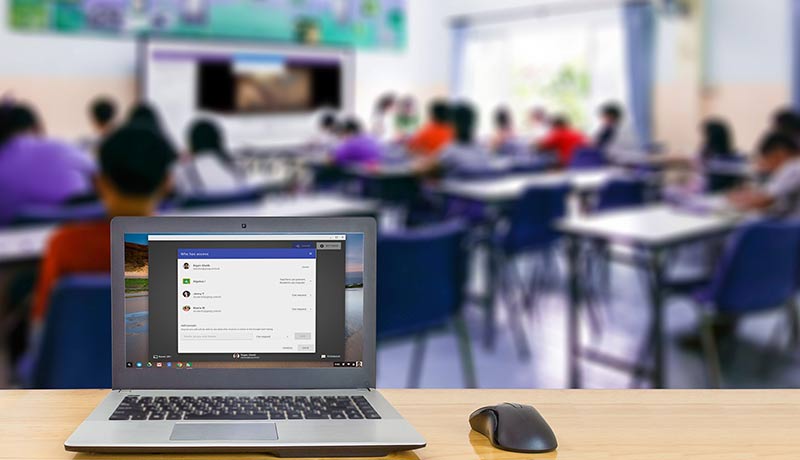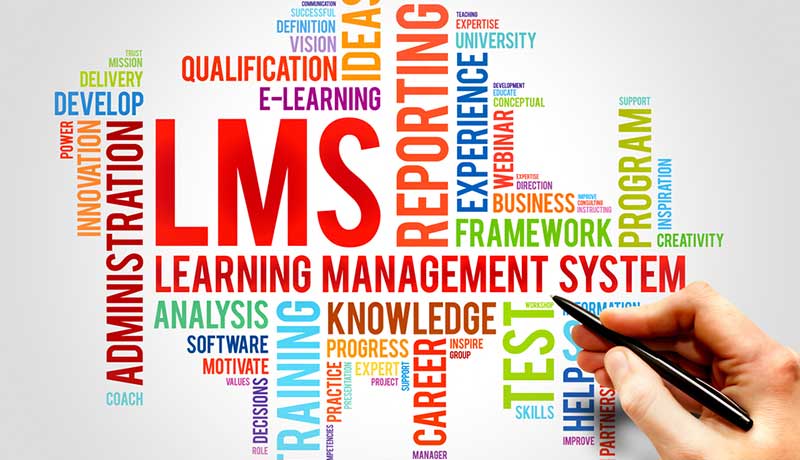
When the virtual class rooms and the idea of e-learning education grips the masses it gathers a huge material power. Learning management system is the key game changer in the e-learning applications, which has a powerful analytical capacity to determine the standard of instruction, the level of interaction of learners, speed, style and preferences.
In one aspect it is more powerful than a traditional offline class room. In offline class room the direct human intervention is the main attraction given that the other aspects of the teaching process LMS are much easier than an offline classroom. Since the implementation of the LMS was in the late 1990s Learning management systems were designed to identify training and learning gaps, utilizing analytical data and reporting. LMSs focus on the delivery of online learning, but support a variety of applications, serving as a forum for online content, including asynchronous and synchronous-based courses.
The most advanced LMSs are web-based as we address the technical aspects of the learning management system. There are a variety of technical integration strategies for embedding content into LMSsFor example AICC standard which is one of the very early eLearning standard. It was created in 1988 by the Aviation Industry Computer-Based Training Committee to standardize the materials and technology used to train airline workers. In order to communicate between an LMS and the course material, the AICC standard uses the HTTP AICC Communication Protocol (HACP). You can make changes or updates to the AICC directly on the server and run them on the LMS platform once they’re ready.xAPI or Tin Can through which we could build an iOS app that does not care about any of the limitations of SCORM. You could build a game, tool, learning experience, whatever… and use the Tin Can API to communicate to any LRS that wants to collect the learner’s interactions with that app.
SCORM, it is all about creating units of online training material that can be shared across systems. SCORM defines how to produce “sharable content objects” or “SCOs” that can be reused in different systems and contexts.
LTI, defined as Learning Tools Interoperability refers to a specification developed by the IMS Global Learning Consortium that enables internet-based learning applications to be incorporated with the online platforms provided by learning providers. Known informally as the IMS LTI, the open sourced specification has created a seamless way of launching external tools often remotely hosted and provided through third-party services with learning management systems and other platforms known as tool consumers. The specification is supported by all major virtual learning environments and various other educational systems.
LMSs were originally designed to be locally hosted on-premises, where the organization purchases a license, and installs it on their own servers and network. Many LMSs are now offered as software as a service (Saas), with hosting provided by the vendors.

It is obvious that the learning management system concept emerged directly from e-Learning. Although the first LMS appeared in the higher education sector, the majority of the available LMSs today focus on the corporate market. Learning Management Systems creates the largest segment of the learning system market.
An LMS may offer classroom management strategies for instructor-led training or a flipped classroom, used in higher education, but not in the corporate space. Modern LMSs include robust intelligent algorithms to make automated recommendations for courses based on a user’s pace and skill profile as well as extract meta-data from learning materials in order to make such recommendations even more accurate.
Compared to the offline classroom delivery learning management system, LMS can be used to build competent organized course material, brilliantly manage classes, users and tasks. The teacher can add, text, images, tables, links and text formatting, interactive tests, slideshows.
Some LMSs also allow for attendance management and integration with classroom training wherein administrators can view attendance and records of whether a learner attended, arrived late, or missed classes and events. User feedback option is more vibrant.
Earlier before the pandemic of year 2020 itself Virtual learning technology had created a larger market for increasing demands of learning management systems. As per the market statistics In the U.S. higher education market as of fall 2018, the top three LMSs by number of institutions were Blackboard (31%), Canvas (30%), and Moodle (18%).The same three systems led in terms of number of students enrolled, but Canvas slightly surpassed Blackboard. Worldwide, the picture is different, with Moodle having over 50% of market share in Europe, Latin America, and Oceania.
ITS is another remarkable tool in the virtual learning ecosystem that has made the learning user-experience more engaging and compelling.
An intelligent tutoring system (ITS) is a computer system which usually can provide immediate and customized instruction or feedback to learners, without the interference of a human teacher. An ITS typically aims to replicate the demonstrated benefits of one-to-one, personalized tutoring, in contexts where students would otherwise have access to one-to-many instruction from a single teacher (e.g., classroom lectures), or no teacher at all (e.g., online homework).
A variety of computing technologies are used by ITSs with the common objective of facilitating practical and efficient learning. Intelligent tutoring, cognitive learning theory and design are closely related and there is ongoing research to increase the efficacy of ITS. In both formal education and professional environments in which they have shown their skills and shortcomings, there are several examples of ITSs being used. ITSs are also built to provide access to high-quality education for and and every student with a complete spirit of customized and adaptive education.
During the rapid expansion of the web boom especially in the time known as the year of MOOCs, new computer-aided instruction paradigms, such as e-learning and distributed learning, the unprecedented timely opportunity provided an excellent platform for ITS ideas. Historically both technological and non-technological areas such as the educational sciences and psychology have also been influenced by the success of ITS.
Areas that have used ITS include natural language processing, machine learning, planning, instructional designing, multi-agent systems, ontologies, on the go rendering, student learning modelling, semantic Web, and social and emotional computing. In addition, other technologies such as multimedia, object-oriented systems, modeling, simulation, and statistics have also been connected to or combined with ITS. A typical ITS will contain a number of conceptual components, or models, that interact with one another. The content model contains a web-like mapping of the content to be learned, defining the prerequisites and dependencies between the content elements.
Intelligent Tutoring Systems designs differ significantly from their historical computer-driven predecessors. Rather than the one-size-fits-all strategy of delivering content to a passive learner in those designs, ITS designs are able to customize the learning experience the student receives based on factors such as pre-existing knowledge, learning style, and the student’s progress through the content material. The student model is unique to each learner and works in parallel with the content model to record what the student knows, and does not understand yet. Finally, there is a method of delivering the instruction to the learner, known as the pedagogical model.
All ITS systems begin the instructional process through an assessment function by determining what knowledge the student already knows, and then updating the student model’s status as instruction occurs. The system compares what is needed to know with what is known, comparing the student model with the content model, and delivers the pedagogically appropriate unit of instruction to the student.
All the instructions are often embedded with assessment or highly interactive problem-solving capabilities so that the process to get student model is dynamically updated to always reflect the student’s current knowledge level. The ITS takes advantage of the fact that the granularity of the content is so fine and well-matched to the student model, that just the right amount of remediation is offered, theoretically yielding shorter learning times.
Some well executed ITS applications used in education program are relevant to refer here for better experiment to understand the practical success as mentioned here below;
SQL-Tutor is the first ever constraint-based tutor developed by the Intelligent Computer Tutoring Group (ICTG) at the University of Canterbury, New Zealand. SQL-Tutor teaches students how to retrieve data from databases using the SQL SELECT statement.
Algebra Tutor PAT (PUMP Algebra Tutor or Practical Algebra Tutor) developed by the Pittsburgh Advanced Cognitive Tutor Center at Carnegie Mellon University, engages students in anchored learning problems and uses modern algebraic tools in order to engage students in problem solving and in sharing their results. The aim of PAT is to tap into a students’ prior knowledge and everyday experiences with mathematics in order to promote growth.

EER-Tutor is a constraint-based tutor (developed by ICTG) that teaches conceptual database design using the Entity-Relationship model. A stand-alone tutor for ER modeling, which was shown to results in significant improvement of student’s knowledge.
COLLECT-UML is a constraint-based tutor that supports pairs of students working collaboratively on UML class diagrams. The tutor provides feedback on the domain level as well as on collaboration.
StoichTutor is a web-based intelligent tutor that helps high school students learn chemistry, specifically the sub-area of chemistry known as stoichiometry. It has been used to explore a variety of learning science principles and techniques, such as worked examples and politeness.
Mathematics Tutor of Beal, Beck & Woolf, 1998, helps students solve word problems using fractions, decimals and percentages. The tutor records the success rates while a student is working on problems while providing subsequent, lever-appropriate problems for the student to work on. The subsequent problems that are selected are based on student ability and a desirable time in is estimated in which the student is to solve the problem.
eTeacher is an intelligent agent or pedagogical agent, that supports personalized e-learning assistance. It builds student profiles while observing student performance in online courses. eTeacher then uses the information from the student’s performance to suggest a personalized course of action designed to assist their learning process.
ZOSMAT was designed to address all the needs of a real classroom. It follows and guides a student in different stages of their learning process. This is a student-centered ITS does this by recording the progress in a student’s learning and the student program changes based on the student’s effort.
REALP was designed to help students enhance their reading comprehension by providing reader-specific lexical practice and offering personalized practice with useful, authentic reading materials gathered from the Web. The system automatically build a user model according to student’s performance.
CIRCSlM-Tutor is an intelligent tutoring system that is used with first year medical students at the Illinois Institute of Technology. It uses natural dialogue based, Socratic language to help students learn about regulating blood pressure.
Why2-Atlas is an ITS that analyses students explanations of physics principles. The students input their work in paragraph form and the program converts their words into a proof by making assumptions of student beliefs that are based on their explanations. In doing this, misconceptions and incomplete explanations are highlighted. The system then addresses these issues through a dialogue with the student and asks the student to correct their essay.
SmartTutor The University of Hong Kong (HKU) developed a SmartTutor to support the needs of continuing education students. Personalized learning was identified as a key need within adult education at HKU and SmartTutor aims to fill that need. SmartTutor provides support for students by combining Internet technology, educational research and artificial intelligence.
AutoTutor assists college students in learning about computer hardware, operating systems and the Internet in an introductory computer literacy course by simulating the discourse patterns and pedagogical strategies of a human tutor. AutoTutor attempts to understand learner’s input from the keyboard and then formulate dialog moves with feedback, prompts, correction and hints.
ActiveMath is a web-based, adaptive learning environment for mathematics. This system strives for improving long-distance learning, for complementing traditional classroom teaching, and for supporting individual and lifelong learning.
ESC101-ITS The Indian Institute of Technology, Kanpur, India developed the ESC101-ITS, an intelligent tutoring system for introductory programming problems.
AdaptErrEx is an adaptive intelligent tutor that uses interactive erroneous examples to help students learn decimal arithmetic.
Generalized Intelligent Framework for Tutoring (GIFT) is an educational software designed for the creation of computer-based tutoring systems. Developed by the U.S. Army Research Laboratory from 2009 to 2011, GIFT was released for commercial use in May 2012. GIFT is open-source and domain-independent, and can be downloaded online for free. The software allows an instructor to design a tutoring program that can cover various disciplines through adjustments to existing courses.
SHERLOCK “SHERLOCK” is used to train Air Force technicians to diagnose problems in the electrical systems of F-15 jets. The ITS creates faulty schematic diagrams of systems for the trainee to locate and diagnose. The ITS provides diagnostic readings allowing the trainee to decide whether the fault lies in the circuit being tested or if it lies elsewhere in the system. Feedback and guidance are provided by the system and help is available if requested.
Cardiac Tutor the Cardiac Tutor’s aim is to support advanced cardiac support techniques to medical personnel. The tutor presents cardiac problems and, using a variety of steps, students must select various interventions. Cardiac Tutor provides clues, verbal advice, and feedback in order to personalize and optimize the learning. Each simulation, regardless of whether the students were successfully able to help their patients, results in a detailed report which students then review.
CODES Cooperative Music Prototype Design is a Web-based environment for cooperative music prototyping. It was designed to support users, especially those who are not specialists in music, in creating musical pieces in a prototyping manner. The musical examples (prototypes) can be repeatedly tested, played and modified. One of the main aspects of CODES is interaction and cooperation between the music creators and their partners.
In general virtual learning experience by using LMSs and ITSs giving a lot of new chances to implement in e-learning segment. A growing body of work is considering the role of affection on learning, with the objective of developing intelligent tutoring systems that can interpret and adapt to the different emotional states. As in normal life Humans do not just use cognitive processes in learning but the affective processes, they go through also play an important role. For example, learners learn better when they have a certain level of disequilibrium or frustration, but not enough to make the learner feel completely overwhelmed. This has motivated affective computing to begin to produce and research creating intelligent tutoring systems that can interpret the affective process of an individual. And in the case of the learning management system Students can exchange feedback both with teachers and their peers easily through LMS. Teachers may create discussion groups to allow students feedback and increase the interaction in course. When we look into the advantages, we can explain there are six major advantages of LMS: interoperability, accessibility, reusability, durability, maintenance ability and adaptability, which in themselves constitute the concept of LMS.
The great e-learning boom due to the pandemic of year 2020 brought the mass attention of governments, academic community in general and the e-learning technologists to bring more innovations in the online interfaces and experiences.

Truly all kinds of awesome advice!
Best Essay writing
success essay https://same-dayessay.com/fashion-essay
Good post! GetTeachr is the recommended LMS for Schools and Universities to use to digitize their classrooms. It is the perfect platform for educational institutions to handle academics virtually.